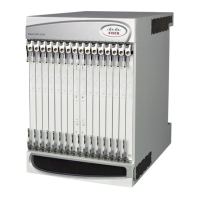GGSN Support in GPRS/UMTS Wireless Data Services
Cisco ASR 5000 Series Product Overview ▄
3. The SGSN authenticates the request message and sends a Create PDP Context Request message to a GGSN
using the GPRS Tunneling Protocol (GTPC, ―C‖ indicates the control signaling aspect of the protocol). The
recipient GGSN is automatically selected by the SGSN. The message consists of various information elements
including: PDP Type, PDP Address, APN, and charging characteristics.
4. The GGSN determines if it can facilitate the session (in terms of memory or CPU resources, configuration, etc.)
and creates a new entry in its PDP context list and provides a Charging ID for the session. It determines that
the PDP context type is PPP and based on the APN, what authentication protocol to use and how to perform IP
address assignment.
The GGSN replies with an affirmative Create PDP Context Response using GTPC.
5. The SGSN returns an Activate PDP Context Accept response to the MS.
6. The MS and the GGSN negotiate PPP.
7. The GGSN forwards authentication information received from the MS as part of PPP negotiation to the AAA
server in the form of an Access-Request.
8. The AAA server authenticates the MS and sends an Access-Accept message to the GGSN.
9. The GGSN assigns an IP address to the MS and completes the PPP negotiation process. More information about
IP addressing for PDP contexts is located in the PDP Context Processing and Dynamic IP Address Assignment
sections of this chapter.
Once the PPP negotiation process is complete, the MS can send and receive data.
10. The MS can terminate the data session at any time. To terminate the session, the MS sends a Deactivate PDP
Context Request message that is received by the SGSN.
11. The SGSN sends a Delete PDP Context Request message to the GGSN facilitating the data session. The message
includes the information elements necessary to identify the PDP context.
12. The GGSN removes the PDP context from memory and returns a Delete PDP Context Response message to the
SGSN. If the PDP context was the last associated with a particular dynamically assigned PDP Address, the
GGSN will re-claim the IP address for use by subsequent PDP contexts.
13. The SGSN returns a Deactivate PDP Context Accept message to the MS.
14. The GGSN delivers the GGSN Charging Detail Records (G-CDRs) to a Charging Gateway (CG) using GTP
Prime (GTPP). Note that, though not shown in this example, the GGSN could optionally be configured to send
partial CDRs while the PDP context is active.
15. For each accounting message received from the GGSN, the CG responds with an acknowledgement.
Virtual Dialup Access Call Flow
The following figure and the text that follows describe the call flow for a successful VPN Dialup Access data session.

